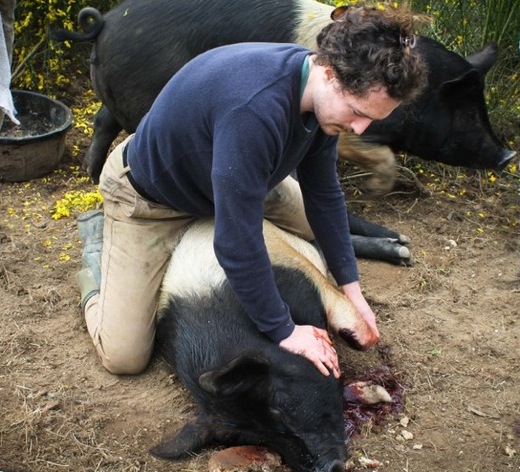SUBHEAD: Flame before spark. Michael Brown in Ferguson Was the spark — Eric Garner in New York is the fire.
By John McWhorter on 3 December 2014 for Time Magazine -
(
http://time.com/3617369/eric-garner-grand-jury-protests/)
 Image above: Eric Garner being choked to death by Ofiicer Pantaleo while three other policeman struggle to hold him down. Garner repeated "I can't breath!" several times before losing consciousness. His offense selling loose cigarettes on the sidewalk. From (http://time.com/3617369/eric-garner-grand-jury-protests/).
Image above: Eric Garner being choked to death by Ofiicer Pantaleo while three other policeman struggle to hold him down. Garner repeated "I can't breath!" several times before losing consciousness. His offense selling loose cigarettes on the sidewalk. From (http://time.com/3617369/eric-garner-grand-jury-protests/).
Here’s a look at the future, and probably not that far into it. People will learn two things:
- That an officer was not indicted for murdering Eric Garner—black, 43, and detained simply for selling single cigarettes—despite the fact that the killing was recorded from start to finish for all of America to see.
- That an officer was not indicted for killing Michael Brown after Brown had stolen from a store, refused the officer’s request to step aside and perhaps tried to grab his gun, with the officer shooting when Brown repeatedly lunged toward him for some reason, with none of this recorded and the details murkily varying from one witness to the next.
Perfectly sensible people will be wondering why so many people in late 2014 thought of the Ferguson case, in particular, as the civil rights case of the 21st century. Yes, Brown should not have died—I have heartily agreed, repeatedly. But people in the future will see the current focus on Ferguson as evidence of people losing sight of the fact that activism is supposed to be about results.
Are we trying to create a humanity devoid of any racist bias, or are we trying to stop cops from shooting black men? The two aren’t the same. A world without racism would be a world without dirt. A world where episodes like what has happened just this year to Garner, Brown, John Crawford, Akai Gurley, and Tamir Rice is much more plausible. We need special prosecutors, body cameras, and, if you ask me, an end to the war on drugs.
As such, we must be pragmatic. I know the people protesting Michael Brown’s death nationwide are sincere. But it’s easy to forget that in cases like this, sincerity is supposed to be forward-focused. It’s all too human for people to end up mistaking the heightened emotions, the threats, the media attention, the catharsis, as progress itself. But drama alone burns fast and bright. Think about how Trayvon is already—admit it—seeming more like history than the present.
Are we really committed to this thing lasting past the winter?
If so, then we have to ask ourselves—is Michael Brown more important somehow because he was killed with a gun? Is Garner somehow less worthy of iconic, implacable protest because he was older than Brown, less “glamorous” than a teenager? Is it, in other words, that Brown is more dramatic?
Because there are other kinds of drama, if we must. For example, Officer Daniel Pantaleo’s statement about Garner is outright tragedy—so disgustingly detached coming from someone’s murderer that it constitutes drama in itself.
“It is never my intention to harm anyone,” Pantaleo says—as if we were thinking now of “harm,” a formal term you can use to refer to a dent in your car. “I feel very bad about the death of Mr. Garner”—my God, “very bad” sounds like he broke someone’s window with a baseball, and “the death of Mr. Garner” sounds like something he watched on TV rather than did with his bare hands. “Accept my personal condolences” says this man twice brought up on misconduct charges before, as if it were his aunt by marriage who passed away after a brief illness.
This, to me, is an articulate testament to how some whites can be unable to see black people as human—and, especially if cops, be more likely to kill them. This, ladies and gentlemen, is a precious teaching moment. Pantaleo’s statement is, in its way, as useful as Reverend King’s Letter From a Birmingham Jail as a look into a human mind.
>Yet one hears that however iffy the Ferguson details are, we should just go with it because it has struck a chord. That our message to America is to be “Even when my son steals from a store, refuses a cop’s order and tries to take his gun, he shouldn’t get shot.”
And he shouldn’t, but wow, what a delicate and hopelessly controversial point that is in such a key moment as this. It’s a tricky, subtle assertion, which has not struck a chord with the disinterested middle because the facts are too murky. We want to make history, not just headlines.
How about this, as a story we can tell the next generation without taking a deep breath and thinking about how to paper over the holes?
Ferguson was the spark, but Garner was “it.”
Here is where I am quite sure Reverend King and Bayard Rustin would be planning not just statements and gestures, but boycotts. The recording of Garner’s death has the clear, potent and inarguable authority of the Birmingham newsreels. We must use that. Yes,
use—we are trying to create change, not just perform.
No Reckless Endangerment?
SUBHEAD: Grand Jury in Eric Garner case wasn't asked to consider 'Reckless Endangerment' charge.
By Andres Jauregui on 5 December 2014 for Huffington Post -
(
http://www.huffingtonpost.com/2014/12/05/eric-garner-reckless-endangerment_n_6275698.html)
The Staten Island District Attorney did not ask the Eric Garner grand jury to consider reckless endangerment charges against NYPD officer Daniel Pantaleo, NBC New York reports.
An unnamed source familiar with the case told the station that District Attorney Daniel Donovan only asked jurors to consider
charges of manslaughter or criminally negligent homicide as they heard evidence.
Under New York law, reckless endangerment entails conduct that causes a
substantial risk of serious physical injury
or death to another person. Garner, a 43-year-old asthmatic, died after Pantaleo put him in a chokehold in July.
The jury determined that there was no probable cause to indict Pantaleo in Garner's death Wednesday, a decision that has been met with
criticism from people across the political spectrum and
sparked nationwide protests.
Although grand jury proceedings are typically sealed by law,
Donovan petitioned a judge to release limited information about them, according to ABC New York. None of the evidence presented was included in the release, only the following:
- Jurors sat for nine weeks
- Testimony was heard from 50 witnesses
- Those witnesses included 22 civilians and 28 cops, EMTs or doctors
- There were 60 exhibits, including videos, records and photos
- The grand jury was instructed in law regarding physical use of force
The D.A.'s office issued a statement Thursday that said he was "constrained by New York law to reveal nothing further regarding these proceedings."
In New York, indictment by grand jury requires at least 12 jurors to agree that there is sufficient evidence and reasonable cause to believe a crime was committed. The D.A.'s role is to present evidence and instruct the jury in the principles of relevant law.
Legal experts told
SILive.com that
Pantaleo's testimony was likely a huge factor in the decision not to indict. The 29-year-old officer, who has received resounding support from the NYPD union, testified before the jury for two hours before Thanksgiving, his lawyers said.
At least one expert who talked to the site was unconvinced by the ruling.
"I'm disappointed in the result. I believe the officer's actions were not necessary to effectuate the arrest of Eric Garner," Mark J. Fonte, a criminal defense lawyer and former prosecutor, said. "It seems to me there was a better way to handle the situation with Eric Garner. No person should lose their life for selling loose cigarettes."
Witnessing a Police Killing
SUBHEAD: David Corn told a grand jury he saw a cop shoot and kill an unarmed man. It didn't indict.
By David Corn on 4 December 2014 for Mother Jones -
(
http://www.motherjones.com/politics/2014/12/grand-jury-witness-police-killing-indictment-david-corn)
 Image above: Painting of man on cover of 1971 Jethro Tull studio album LP record "Agualung". From (http://en.wikipedia.org/wiki/Aqualung_%28Jethro_Tull_album%29).
Image above: Painting of man on cover of 1971 Jethro Tull studio album LP record "Agualung". From (http://en.wikipedia.org/wiki/Aqualung_%28Jethro_Tull_album%29).
Many years ago, during the 1980s, I witnessed a killing: a New York City cop shooting an unarmed homeless man near the Metropolitan Museum of Art. I was later called as a grand jury witness in the case. The grand jury did not indict the officer.
It was a summer evening. I was heading to play softball in Central Park. At the corner of Fifth Avenue and 79th Street, I got off my bicycle to walk toward the Great Lawn. The west side of Fifth was crowded with New Yorkers enjoying the beautiful night. People were streaming in and out of the park. Sidewalk vendors were doing brisk business. The vibe was good.
And in the midst of the hubbub, I spotted a fellow wearing dirty and tattered clothing. His hair was filthy, his face worn. It was hard to determine his age. He reminded me of Aqualung. (See this
Jethro Tull album cover.)
He was carrying a large and heavy rock with both of his hands, pushing his way through the throng, and muttering unintelligible words. I wondered, what's his story? But I didn't give it much more thought.
Most of the people on the corner were not paying attention to him. Those in his direct path, as he lumbered north, did quickly step out of his way. But no one seemed much alarmed by the guy. In New York City, unfortunately, you often saw broken people—and shrugged them off as just another crazy.
I was about to head down the footpath toward the baseball fields, when I saw a commotion to my right. Several police officers—four or so, I recall—were approaching the man with the rock. And their guns were drawn. As they neared the fellow, he dropped the rock, he then began to run in the same direction he had been walking.
The cops were not grouped together; they were spread out—in a circle that was drawing tighter. The man, displaying a fair degree of agility, leaped into the street and tried to cut between two of the officers to get away.
Shots were fired. Two or three. Maybe four. And he went down.
The cops surrounded the man. He didn't move. This was no longer a person. This was a body.
I moved closer to the scene. Passersby had stopped to watch. It was still difficult to assess his age. His clothes were a grimy gray. I saw his dirty hands. Both were empty.
Soon police cars and an ambulance arrived. The paramedics did not move fast. They covered the body with a sheet. Several police officers were standing around a female officer. She was in anguish. They were consoling her. It was obvious: She had fired the shots that killed the man.
Her race? She was white. His skin color? I thought it was dark, but it was tough to tell if it was dirt or pigment.
Cops were buzzing about the scene. Flashing lights illuminated this ritzy stretch of Fifth Avenue. On-lookers gawked. And I noticed something that struck me as odd: The police officers were not talking to any of the witnesses. They were talking to each other and the paramedics. I approached one cop and said that I had seen it all. He wasn't impressed and looked at me as if to say, "So what?" I had thought the police would want to round up eyewitnesses to the shooting.
"Shouldn't I talk to someone?" I asked this officer. He nodded his head toward another policeman. I went up to that cop. "Excuse me, officer," I began. "I saw what happened." Again, I received a look of disinterest. "Shouldn't I...." He cut me off: "Talk to him." He was looking at another officer who was barking instructions to other cops.
I tried once more. I approached this officer who seemed to be in charge. "Officer, I saw...." He shut me up with a wave of his hand, signaling I should wait. And wait I did, as he directed other cops to do this or do that. The paramedics were preparing to cart off the body. After a few minutes, I went up to this officer again and told him I had witnessed the whole episode.
"Okay," he said.
He said nothing else. He didn't ask me for my name. He didn't ask if I would provide a statement. I was surprised by his lack of interest.
"Shouldn't I tell someone what I saw," I said.
"If you want to," he said, not in an encouraging tone.
"Okay, who do I talk to?" I ask.
"If you
want to make a statement," he said, as if I was inconveniencing him and the entire police force, "you can go down to the station and do it there." Now I got it: He didn't want my statement, even though he had no idea what I would say. He was not interested in taking my name and contact information. It was my job apparently to make it to the police station on my own, and the station was a mile or so south.
This ticked me off. He was essentially trying to shoo me away. As the paramedics were loading the body on to the ambulance and as the cop who had shot the man was surrounded by her colleagues, I got on my bike and started to ride down Fifth.
At the station, I approached the front desk and told the officer staffing it that I had witnessed the shooting and had been told to come to the station to provide a statement. This fellow looked surprised to see me. He asked me to wait on a bench.
I waited. Five minutes, fifteen minutes. I went back to the desk. Yes, yes, I was told, someone will be with you shortly. Another five minutes, another fifteen minutes. Obviously, no one would have minded if I gave up and left.
Sitting next to me in this waiting area was a woman—middle-aged and white (if that matters)—who was also a witness. We probably weren't supposed to compare our accounts, but we did. (No one had told us not to.) She mentioned that she thought she had seen the victim holding something in his hand, perhaps a knife, when he started to run.
Her vantage point had not been as good as mine, and I told her that I had seen the man drop the big rock and immediately begin to run. There had been no time for him to pull out a knife. Moreover, I had been in a position to see his hands—before and after he was killed—and I saw no knife. We looked at each other and didn't know what else to say.
Finally, a detective—I think he was a detective, he didn't say—came over and gave me a form on a clipboard and asked me to write a statement of what I had seen. I did. I stuck to the facts: nutty-looking homeless man carrying a small boulder, approached by cops, drops rock and runs, cops get closer, he darts between two of the officers, cop fires on him.
It was clear to me that the officer did not have to shoot the man. He was not threatening the officers. He was trying to run from them. But I didn't write down this conclusion. I presented the facts; I believed their implication were undeniable.
When I finished, I handed my statement to one of the officers. I was told, "You'll be contacted, if that's necessary." None of my interactions with the police led me to believe that a thorough investigation was in the works.
As I left the station, I saw the female officer who had fired the fatal shots. She was with several colleagues. She was upset and appeared to be crying. The other cops were being supportive. I couldn't help but feel sorry for her. My interpretation was that she had screwed up; she had overreacted or panicked and fired her shots too soon. My hunch was that she knew that.
The next day—this was long before the internet era—I checked the newspapers and saw no stories on the shooting. Some time later—I think it was a couple of months—I received a call. A grand jury was examining the shooting, and my presence was requested.
I went to the courthouse at the appointed hour and waited to be called into the grand jury room. My time in the drab conference room with the grand jury was brief. The jury was, as they say, a diverse group. But most of the jurors looked bored. A few seemed drowsy.
The prosecutor asked me to identify myself and certify I had filed the statement. He asked me to describe where I had been and whether I had seen the full episode. But he never asked me to provide a complete account. The key portion of the interview went something like this:
Prosecutor: You saw him start to run?
Me: I did.
Prosecutor: Did you see anything in his hand?
Me: No.
Prosecutor: Did you see him holding a knife?
Me: No. But I....
Prosecutor: Thank you.
I had wanted to say that I had seen him drop the heavy rock and bolt and that it was unlikely he had been able to grab and brandish a knife while sprinting. And I thought the grand jurors should know that he had not charged at any of the officers; he had been trying to dash through an opening between two of the cops in order to flee. And if they were interested in my opinion regarding the necessity of firing on him, I would have shared that, too.
But the prosecutor cut me off. He didn't ask about about any of this. And not one of the jurors asked a question or said anything.
I left the room discouraged. This was not a search for the truth. It appeared to be a process designed to confirm an account that would protect the officer who had killed the man. The prosecutor was in command and establishing a narrative. (A knife!) The jurors appeared to be only scenery. (Insert your own
ham sandwich reference here.)
Long before the present debate spurred by the non-indictments in the Michael Brown and Eric Garner cases, it seemed clear to me that the system contained a natural bias in favor of police officers. That certainly makes sense. Police officers have damn tough and dangerous jobs, and they are going to look out for their comrades-in-blue who slip up.
And prosecutors work closely with cops to rack up convictions, and they don't want to alienate their law enforcement partners. No one in that grand jury room was there to serve the interests of the dead guy.
On the way out of the courthouse, I realized I did not know the name of the victim.
I subsequently called a reporter who worked on the metro desk of the
New York Times to tell him about my experience, hoping the paper would dig into the case. But I never saw a
Times story on it. (At the time, I was working for a magazine that covered arms-control issues and in no position to write about the event. And back then, there was no equivalent to tweeting, blogging, or Facebooking.)
Several weeks, or a month or two, after my grand jury appearance, I called the person who had contacted me about testifying. Whatever happened? I asked. Oh, the man said, the case is over. I took that to mean the officer was not charged. Before I hung up, another question occurred to me.
I don't know why I thought about this, but I asked, "Whatever happened to the body of the man who was shot?" He was never identified and buried somewhere, he replied. And I wondered, never identified? How hard did they try?
.







